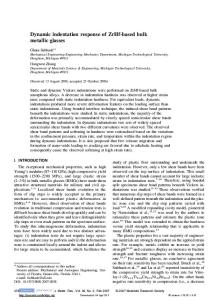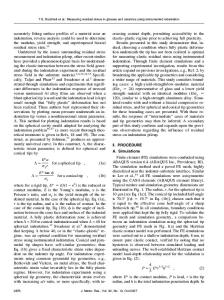Instrumented indentation study of plastic deformation in bulk metallic glasses
- PDF / 158,816 Bytes
- 7 Pages / 612 x 792 pts (letter) Page_size
- 105 Downloads / 447 Views
T.H. Zhang and D.M. Xing State Key Laboratory of Nonlinear Mechanics, Institute of Mechanics, Chinese Academy of Sciences, Beijing 100080, People’s Republic of China
B.C. Weia) and Y.R. Wang National Microgravity Laboratory, Institute of Mechanics, Chinese Academy of Sciences, Beijing 100080, People’s Republic of China
Y.D. Dong Institute of Materials, Shanghai University, Shanghai 200072, People’s Republic of China (Received 6 February 2005; accepted 28 June 2005)
Mechanical properties and micro-plastic deformation behavior of five bulk metallic glasses (BMGs) were studied by instrumented indentation. These materials included La60Al10Ni10Cu20, Mg65Cu25Gd10, Zr52.5Al10Ni10Cu15Be12.5, Cu60Zr20Hf10Ti10, and Ni60Nb37Sn3 alloys. Remarkable difference in deformation behavior was found in the load–displacement curves of nanoindentation and pileup morphologies around the indents. Serrated plastic deformation depended on the loading rate was found in Mg-, Zr-, and Cu-based BMGs. The subsurface plastic deformation zone of typical alloys was investigated through bonded interface technique using depth-sensing microindentation. Large and widely spaced shear bands were observed in Mg-based BMG. The effect of loading rate on the indentation deformation behaviors in different BMGs was elucidated by the change of shear band pattern.
I. INTRODUCTION
Although bulk metallic glasses (BMGs) have shown potential as structural materials due to their high strength, high hardness, good wear resistance, excellent elasticity, and easily forming in viscous state, applications are currently limited by the lack of any significant plastic deformation at room temperature. Understanding the micro-mechanisms of plastic deformation and developing the constitutive relationships for BMGs is an active area of research.1–7 As an excellent tool to determine mechanical properties on a local scale, nanoindentation has been intensively studied in the thin film and nanocrystals material.8–10 Recently, nanoindentation has been proposed as a key method for the study of localized deformation by shear banding in BMGs.5,11–17 A growing number of authors have considered the formation of individual shear bands by nanoindentation, where displacement bursts in the Load-displacement (P-h) response have been correlated with discrete shear banding events.12,14 It is found that the character of serrated flow depends strongly on the composition and structure of a)
Address all correspondence to this author. e-mail: [email protected] DOI: 10.1557/JMR.2006.0037 J. Mater. Res., Vol. 21, No. 1, Jan 2006
http://journals.cambridge.org
Downloaded: 15 Mar 2015
BMGs, as well as the applied strain rate during nanoindentation measurements.12–14,17 The Pd-based alloys exhibit sharper displacement bursts than for Zr-based materials at the same loading rate.12 Schuh et al. constituted a new high-rate regime of homogeneous flow on the deformation map of metallic glasses.5,12,13 They suggest that there is a transition in plastic flow behavior in which serrations are suppressed at h
Data Loading...











